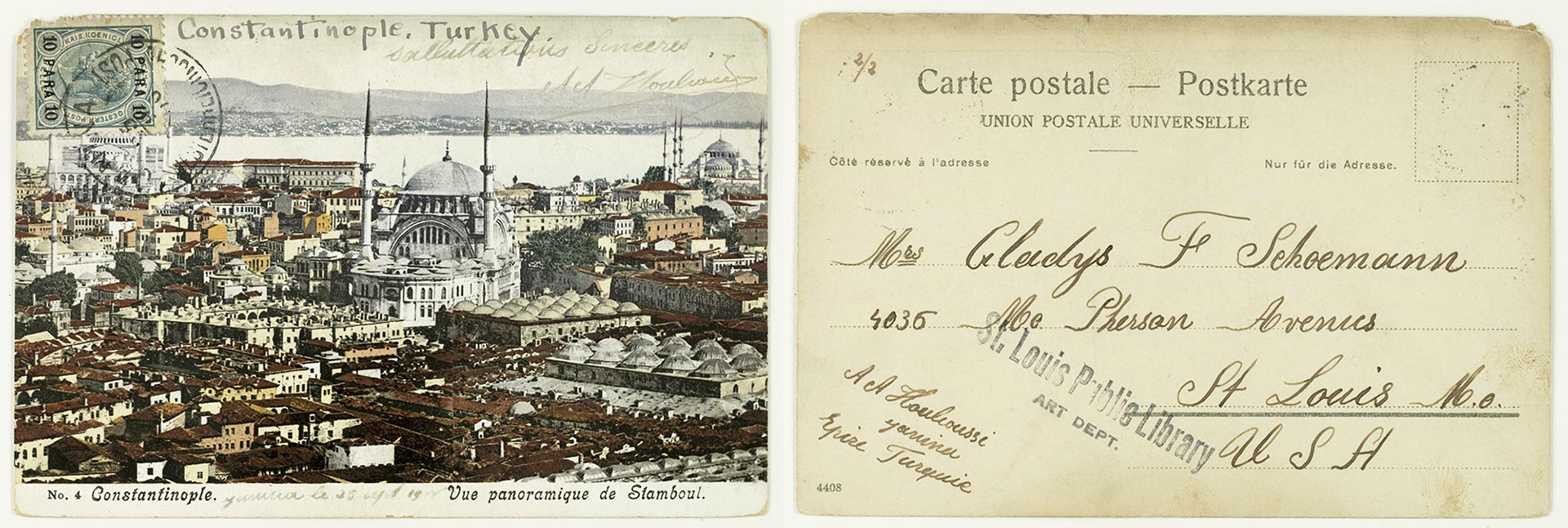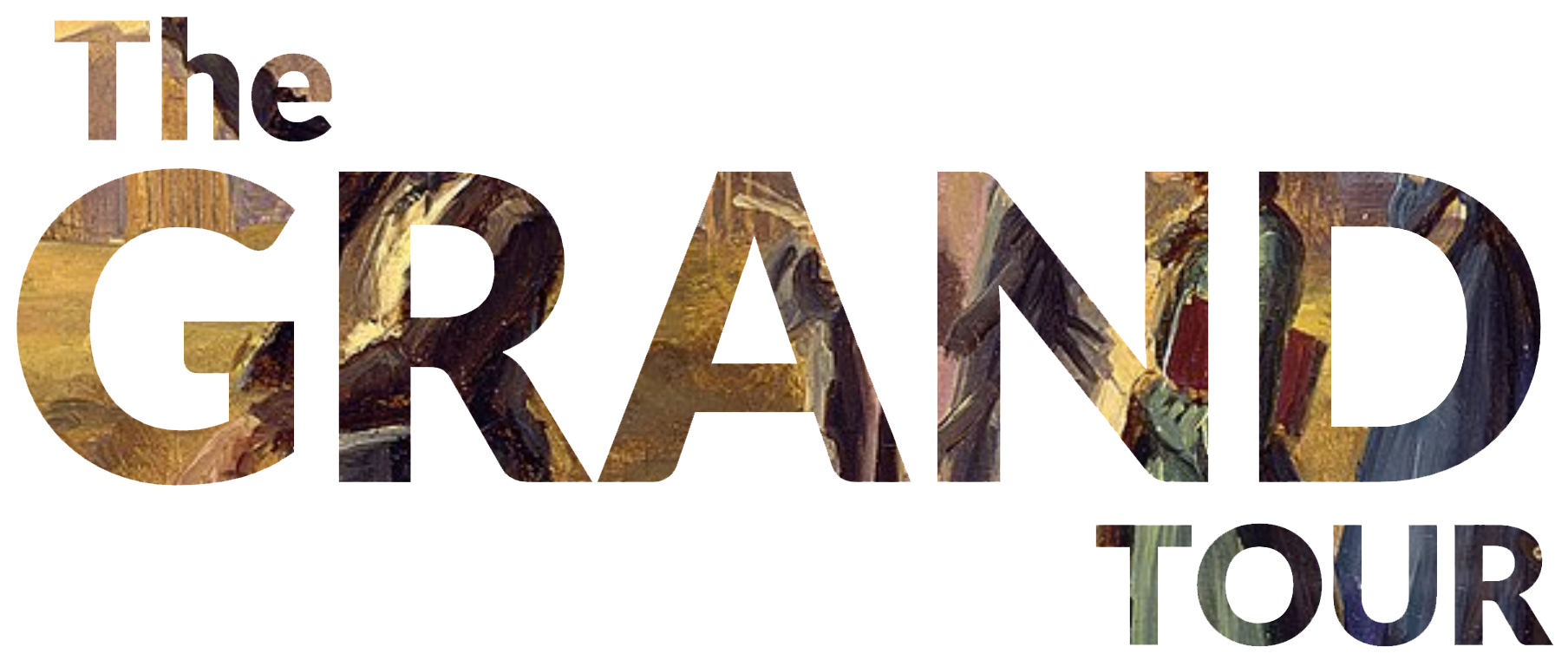Postcards
Picture postcards became hugely popular in the United States in the 1890s. They were used for every type of communication; as advertisements, to promote civic pride, to picture celebrities, and most popularly, as souvenirs of travel and faraway sights. Postcard albums were proudly featured in parlors across the country. Newspapers discussed “the postcard craze.” Printing and selling postcards was a major business around the world, including here in St. Louis.
You might think of postcards as the Twitter of their day! Critics decried the sad effect of the brevity of postcards on the fine art of letter-writing. By 1913, the U.S. Post Office recorded over 900 million postcards mailed in this country alone. The years between 1905 and 1915 are sometimes called the Golden Age of Postcards, when the variety, quality, and sheer numbers reached their peak.
The Rock from the Bathing Pavilion at Linea Gibraltar ca. 1920
1 / 19

Once viewed as the end of the known world, the Rock of Gibraltar soars high above the southwestern tip of Spain, where the Atlantic Ocean meets the Mediterranean Sea. Spain became more popular with Grand Tourists at the beginning of the 20th century.
Cairo, Egypt - Sphinx and Pyramids ca. 1920
2 / 19

Because of its rich archeological discoveries, Egypt was a popular destination for tourists. This postcard was photographed and printed by Rudolf Franz Lehnert and Ernst Heinrich Landrock who had a very successful photography company known for its cultural and exotic prints. Their rotogravure, high quality prints were used to produce original postcards between 1910 and 1930. The prints are still being sold today.
Neuschwanstein Castle, Munich Germany ca. 1850
3 / 19

Perched precariously on a rugged hill in southern Germany, this 19th century Romanesque Revival castle was built as a retreat for King Ludwig II of Bavaria and as an homage to the German composer Richard Wagner. It was also the inspiration for Disney's Cinderella Castle at the Magic Kingdom. The castle remains an attraction today with more than 6,000 visitors a day.
The Arch of Titus - Rome, Italy ca. 1937
4 / 19

The Arch of Titus, commissioned by Roman Emperor Domitian (circa AD 81) is the only one of three Roman triumphal arches that has survived today. This arch was the inspiration for the Arc de Triomphe in Paris, France. The Colosseum of Rome, the largest amphitheater in the world, can be seen in the background of this exquisite photo.
Ca' d' Oro - Venice, Italy ca. 1910
5 / 19

Translated as "house of gold" this building was named for the initial gildings on the facade of this late gothic palace on the Grand Canal in Venice. Built between 1421 and 1438, it was donated along with its art collection to the Italian State in 1916. The publisher of this postcard, G. Ricordi & Co, primarily published classical music and opera. The Ca' d'Oro remains a popular Venetian tourist sight today.
The Beach and Promenade at Dover, England ca. 1910
6 / 19

With the distinctive white chalk cliffs at Dover in the background, tourists of 1910 frolicked in the waters of the English Channel. Only 21 miles from France, the cliffs provided a strategic location for the British in both world wars. Dover is now part of England's National Trust that protects historic homes, buildings, gardens, parks, nature, wildlife, coasts, countryside, collections, sites, and monuments.
Venezia Piazza S. Marco - Volo de Piccioni, Venice, Italy ca. 1920
7 / 19

The Piazza San Marco, known simply "the piazza" in Venice, is the social, religious, and political center of this major Italian city. Facing the piazza are the Basilica of St. Mark, built in 1073: the Campanile, an exact replica of a 10th century watchtower: the Doge's Palace once belonging to the chief magistrate or leader of Venice: museums, cafes, magnificent architecture, and pigeons. For more than a century, the birds have become nearly as iconic as the historic buildings they perch on.
Grotte de glacier des Bossons L'echelle ca. 1920
8 / 19

Pictured in this color photograph from the Greensfelder Postcards Special Collection, is a well-dressed tour group descending icy steps and ladders to enter a cave on the Bossons Glacier. Located in the Chamonix Valley in Southeast France, it is the only Mont Blanc glacier to reach the valley floor.
Paris le Nouveau Louvre - Place du Carrousel - Monument de Gambette ca. 1900
9 / 19

Originally built in the 12th century as a fortress on the Seine River, the Louvre underwent repeated reconstruction and uses over the centuries including the palace of Louis XIV in the 17th century. By the late 18th century it was opened to the public as a museum of art. Today the Louvre houses one of the largest and most important collections of art in the world. The Palace du Carousel refers to the public square at the open end of The Louvre. Once nearly 20 feet tall, the Gambette Monument has been dismantled over the years and only the base exists today.
La Sainte Chapelle
10 / 19

Artist Charles Pinet (1867 - 1932) etched tis image of La Sainte Chapelle, one of several etchings of French churches he created for postcards. Completed in 1248. Sainte Chapelle is located in the heart of Paris along the Seine River. The royal medieval Gothic chapel is noted for its extensive collection of 13th century stained glass windows.
Picadilly Circus, London, England
11 / 19

You won't find any high-wire acts at this busy London intersection. Picadilly refers to a 17th century filled collar named piccadill created by a local tailor. And the word "circus" refers to a roundabout used to guide traffic. This photo shows the Shaftesbury Memorial Fountain built in 1893 in honor of Lord Shaftesbury. Advertisements, like the ones seen in the photograph, began appearing in 1895, and by 1923 giant electric billboards were set up on the facade of the London Pavilion. The intersection is no longer a circle, but it is still a busy shipping, theater and entertainment district.
Broad Street, London ca. 1900
12 / 19

The bustling street scene depicted in this color photograph is from the Eyre & Spottiswoode's Woodbury Series in the Library's Postcard Special Collections. Eyre and Spottiswoode, Ltd. was the official King's printer in the 19th century, which included exclusive rights to print and publish the St. James Bible. The company was in business from 1845 to the 1879's, manufacturing Christmas cards before the inception of postcards. The suburban train station opened in 1865 and eventually closed in 1986 due to its low use. The Broad Street Station was replaced by the enormous Broadgate office and shopping complex.
Geneve. Ile J.-J. Rousseau at Pont du Mont Blanc
13 / 19

This color photo translates to Jean-Jacque Rousseau Island and the Mont Blanc Bridge. Located ta the mouth of the Rhone River, Rousseau Island was once an ancient bastion\surrounded by walls. In 1832 a park was created and a statue of Enlightenment philosopher and writer Jean-Jacques Rousseau was erected.
Chamonix - Montonvert (1913 m) et al mer de glace
14 / 19

Translation of this panoramic view, Montonvert and the sea of ice, was also known in the 18th century as Montonvert Glacier. Situation on the northern slopes of Mont Blanc, France's largest glacier was a popular tourist destination in the 19th century and its wonders can be found in travel guides, novels and art of the period.
Hamburg-Amerika Linie, An Bord des Dampfers "Kaiserin Auguste Victoria" ca. 1900
15 / 19

The Hamburg-America Line, established in 1847, was the first German transatlantic steamship line. The SS Kaiserin Auguste Victoria regularly sailed between Hamburg and New York until the outbreak of WWI in Europe. In 1919, the ship became the USS Kaiser in Auguste Victoria and made five crossings bringing troops home from France after the war. Note the green Benjamin Franklin stamp issues on Feb. 3, 1903. The stamp paid the one-cent first class postcard rate.
Constantinople, Bue panoramique de Stamboul ca. 1900
16 / 19

This magnificent panoramic color photo of Constantinople, Turkey shows the Hagia Sophia in the center, a cathedral built in the sixth century CE. The ancient city of Constantinople was built in the seventh century CE> It was the capital of the Byzantine Empire until its fall in 1453, and then the Ottoman Empire until 1930 when it was renamed Istanbul. In addition to the Hagia Sophia, 19th century travelers would have marveled at the Topkapi Palace (far left) and the Sultan Ahmed Mosque/Blue Mosque (far right).
Dresden, Albertplatz mit hauptstrasse ca. 1900
17 / 19

The snow-packed streets of Dresden with streetcars, horse-drawn carriages and pedestrians provide a picturesque winter scene that many travelers sought out on The Grand Tour. Located on the River Elbe, Dresden today lies in the Saxony region close to the Czech border.
Berline, Hochbahn u. durchbrochenes haus in der Bülowstrasse ca. 1900
18 / 19

Belins' Bülowstrasse, elevated rail station was opened in 1902, and was part of the capital city's U-Bahn. Untergrundbahn or underground railway. The station was named after the Prussian general of the Napolionic Wars Friedrich Wilhelm Frieherr von Bülow. The rapid transit railway is still in operation running trains every two to five minutes during peak hours.
Berlin, Oberbaumbrücke ca. 1910
19 / 19

This black and white photo of the Oberbaum Bridge, a double-deck bridge crossing Berlin's River Spree and U-Bahn railway Stralauer Tor station. The station was destroyed in 1945 during World War II. The original timer drawbridge was built in 1724. The modern day bridge opened in 1896 as a double-deck bridge with traffic on the lower part and trains on the upper deck. The bridge, with its distinctive mock medieval turrets, is considered one of the city's landmarks.
